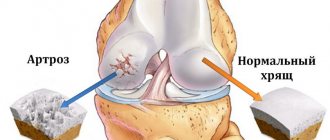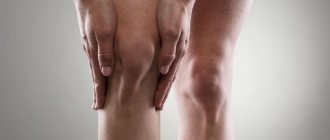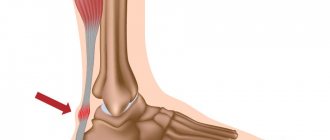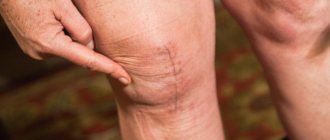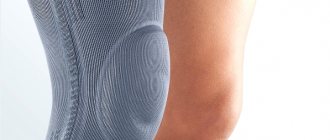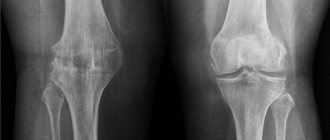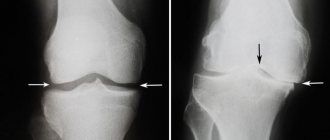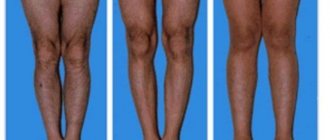In therapy arthrosis physical therapy (physical therapy) is important. However, the principle of “do no harm” must be observed here. In the initial stages of the disease, when the joint has not yet been destroyed, active movements can be useful; they will help stop the development of the disease. However, in more severe cases, when the joint is already significantly damaged, the same exercises can accelerate the destruction of the joint and cause a serious exacerbation of the disease.
Therefore, if you have been diagnosed with “ arthrosis ”, or you suspect that you have this disease, you need to undergo an examination and consult with a specialist in exercise therapy to choose the right set of exercises and the correct method of performing them.
Why do athletes develop arthrosis?
It is no coincidence that arthrosis is called the disease of athletes. There are a lot of provoking factors in this category:
- trauma and microtrauma;
- metabolic disorders due to regular non-physiological stress;
- excessive stress on joints;
- hormonal imbalances due to taking special medications;
- lifting excessive weights on a constant basis;
- performing repetitive exercises when playing hockey, football, tennis, running;
- desire to lose weight quickly, etc.
Athletes most often experience gonarthrosis and coxarthrosis
Important!
It is possible and necessary to maintain physical activity and enjoy it with arthrosis. But in reality this is only outside the acute period of the disease, when the joint is not too bothered. With severe pain syndrome, this is simply impossible, because in such situations a person not only cannot ski or visit the steam room, but is forced to move around his own apartment with a cane.
Therefore, after diagnosis, it is important to get the disease under control as quickly as possible. This is not only about pain relief, but also about maintaining metabolism in cartilage tissue. The main goal of treating arthrosis is to stop further destruction of intra-articular cartilage. For this purpose, drugs from the group of chondroprotectors are used, which increase the moisture content in cartilage, increase its elasticity and strength, and stimulate regeneration processes in it.
Such products can be made on the basis of chondroitin sulfate, glucosamine, or a combination of both. These are substances that are normally found in the human body and support the functioning of cartilage tissue. However, with arthrosis, there is a deficiency of them that needs to be replenished.
Chondroprotectors are taken in courses that last at least three months and then repeated regularly. You should not stop taking medications ahead of time, even if you feel much better. Only this approach can ensure the joy of movement.
What sports are allowed for arthrosis?
Of course, if you have been prescribed treatment for arthrosis of the knee joint, you will have to reconsider your training regimen and completely abandon intense stress on your knees. To properly plan the load on the joints, you will need to consult a specialist. Completely giving up physical activity is a big mistake. Exercises will help strengthen the periarticular muscles, but will not have a negative effect on the affected cartilage fibers.
Orthopedists allow:
- engage in race walking, without sudden movements;
- train on an exercise bike and ride a bike on a flat road;
- squat;
- perform stretching and bending exercises;
- To do yoga;
- swim;
- play table tennis;
- to play golf.
For arthrosis, the best sports are swimming and cycling.
Pedal off!
If you have arthrosis of the knee or hip joint, doctors prohibit jogging and aerobics and ask you to avoid activities associated with lifting weights.
Article on the topic Arthrosis: truth and myths about joint problems But training on an exercise bike is even recommended. When we pedal, movements in the joint occur smoothly, progressively, and the cartilage tissue is not injured.
At the same time, the muscles of the thigh and lower leg work, blood circulation improves, and therefore nutrition of the joint, and its mobility increases.
During the warm season, you can also ride a real bicycle. In addition to a good load, it also gives a positive emotional charge.
Keep in mind!
- Modern exercise bikes allow you to set the pedal resistance. If you have arthrosis, it should be such that you have to make an effort, but you are not forced to make sharp pushing movements, “beat” the pedals. Otherwise, this will lead to microtraumas of the joint, which contribute to the progression of the disease.
- It is recommended to start cycling training with 15–20 minutes, gradually increasing the time to 35–40 minutes.
- Do not ride a bicycle on uneven surfaces. This is accompanied by shaking, which again leads to microtrauma.
- You can’t exercise “through pain.” There is an opinion that this helps develop the joint, but in reality such training only leads to accelerated destruction of cartilage tissue.
TOP 4 best sports for arthrosis
If you played football or basketball before treatment for hip arthrosis, now is the time to switch to more gentle physical activity. If you wish, you can also achieve good sports results here.
1. Race walking.
Avoid walking only if you are noticeably overweight. If your weight is normal, choose the appropriate option - Nordic walking, exercise on a treadmill at low speed, or on an orbit track. Training will be a good prevention of arthrosis and will stop its progression. You will be able to improve blood circulation, eliminate stiffness, strengthen ligaments, and activate the muscles around the joints. Over time, you will notice an increase in the range of motion in the affected joint.
Obesity is the only contraindication to race walking with arthrosis
2. Cycling.
You can exercise on an exercise bike or bicycle at any time of the year when there is no aggravation in the joint. Training strengthens the muscles of the thigh, lower leg, ligaments, improves blood circulation and tissue nutrition. The main thing is to monitor the smoothness of movements and avoid increased tension and jerking.
3. Skis.
When skiing, the load on the joints is even less than when walking, due to sliding. You can ski in good weather, on a prepared, flat ski track - only with the classic skiing. Skating (sliding the leg forward and to the side) is harmful to the joints. The main rule is no jerks or accelerations, no maneuvers or potentially dangerous descents.
Cross-country skiing - yes! Ski slopes - no!
4. Swimming.
While swimming, you train the damaged joint without excessive pain, since in water the load on it decreases significantly. Depending on the degree of arthrosis of the shoulder joint, knee or hip, a style is selected - breaststroke, freestyle, backstroke.
How to strengthen your knees? This question worries almost everyone who is somehow connected with sports. Expert recommendations:
Doesn't steam break your bones?
Visiting a sauna or bathhouse is useful for many problems with the musculoskeletal system, and arthrosis is no exception. Thermal procedures lead to increased blood circulation and improved nutrition of the joints.
Heat helps relieve muscle spasms, which often occur in the affected area, and strengthens and makes the ligaments more elastic. And profuse sweating allows you to remove decay products from the body and activates regeneration processes.
Keep in mind!
- The question of visiting the bathhouse should be discussed with your doctor in advance. Thermal procedures are prohibited if there is inflammation in the joint. Arthrosis is a disease primarily caused by metabolic disorders rather than inflammation. But at certain stages inflammation may occur, at which time you should avoid visiting the steam room.
- Hypothermia of the joints is extremely undesirable, so you should not dive into the font when leaving the steam room. Take a warm or cool (not cold!) shower. Article on the topic: How to treat a joint? The most common methods of getting rid of arthrosis
What sports are prohibited for arthrosis?
Physical activity during which the joint experiences heavy load, jerking and sudden movements aggravate the course of the disease. Therefore, such potentially dangerous sports will have to be abandoned:
- football;
- basketball;
- volleyball;
- hockey;
- tennis;
- ski jumping.
With arthrosis, athletes are contraindicated in forced exercises - actions that are constantly repeated. Axial and impact loads (running, jumping), wide-amplitude movements, for example in martial arts, and full extension of the knee joint are prohibited. You should not train with pain of any intensity, or expose your joints to excessive stress.
Yoga and Pilates are excellent activities for arthrosis, with the exception of exercises in a kneeling position
Particular attention when performing exercises is for elderly patients
Elderly patients suffering from deforming arthrosis, when performing exercises, must remember that running, jumping, exercise with weights, as well as all types of competitions are excluded even in a state of remission. You should also exclude exercises with prolonged holding of breath, sudden movements, rotation of the head, long tilts of the head down, jumps, etc.
No matter how useful physical exercise is for arthrosis, it is important to follow three principles: caution, gradualness, and regularity. Remember - even physical therapy if done too hard can accelerate the destruction of the joint.
Read more about NANOPLAST forte
What joints are affected when playing sports?
| Kind of sport | For which joints is it most dangerous? |
| Basketball | Shoulder, knee, wrist |
| Running, football | Knee, hip, ankle |
| Bodybuilding, judo | Shoulder, knee |
| Boxing | Wrist, knee |
| Horseback riding, skiing | Knee, hip |
| Table tennis, surfing, shooting | Shoulder, elbow, wrist |
| Hockey | Knees, ankles |
| Fencing | Shoulder, knee |
| Weightlifting | Knees, hips, shoulders |
| Jumping sports, skydiving | Hip, knee, ankle |
| Mountaineering | All joints |
What physical exercises can you do at home?
For joint health and restoration of their function, it is recommended to engage in physical therapy. Such activities do not require much effort and time, and they are also not financially expensive. Depending on the stage of the disease, the doctor will recommend certain exercises.
Walking with arthrosis
Most orthopedists are almost unanimous: walking is beneficial for osteoarthritis of the knee joints. It not only has a preventive effect, preventing the onset of the disease, but is also a good remedy. While walking, a number of positive changes occur in the body:
- Is it possible to do Nordic walking with arthrosis of the knee joint, the correct walking technique
- Improved blood circulation due to the functioning of the respiratory and cardiovascular systems - and, therefore, an increase in the delivery of nutrients to cartilage and bone tissue.
- Increased tone of working muscles.
- Strengthening the ligaments of the joint.
- Disappearance of stiffness.
- Expanding range of motion.
But even such a common activity as walking has its limitations. It should be noted that with grade 2-3 osteoarthritis of the knee, long treks, tourism, even a regular trip with bags from the store can become difficult. Although the load on the knee joint is significantly less than when running, you should not neglect safety measures by overloading the sore joint. Short walks are the best option for osteoarthritis of the knee joint.
Running and arthrosis of the knee joint
It is known that when running, the load on the knee increases more than five times compared to the normal state. Therefore, even against the backdrop of positive aspects (increased blood circulation, acceleration of general and local metabolic processes), overload of the articular apparatus has a significantly more negative effect. This can lead to accelerated cartilage destruction and disease progression.
You should not engage in the following active sports, which include running:
- Football.
- Tennis.
- Hockey.
- Basketball.
- Volleyball.
- Badminton.
- Skiing.
Doctors unequivocally state that running is contraindicated in the second degree of arthrosis of the knee joint. Even with initial changes in the joints, the benefits of running are not supported by everyone. Only light short runs can be recommended. But in any case, you should definitely consult with your doctor to assess the benefit-risk ratio. Whether to run or not with arthrosis of the knee joint will be decided only by a qualified specialist, having considered the pros and cons of each specific case.
Is it possible to squat with arthrosis of the knee joint?
You should also be careful with squats. Many doctors do not recommend performing them at all for osteoarthritis of the knee, while others recommend limiting them as much as possible, trying to ensure that the following conditions are met:
- Perform squats in such a way that you do not bend your knees completely. In this case, the load on the joint is less.
- If squatting is not yet recommended, then you can perform the following exercise: lying on your back and without lifting it from the floor, bend your knee, trying to pull your heel towards your buttock.
- It is good to perform squats for knee arthrosis in water, as this reduces the load on the joint.
It must be remembered that improper squats, even in healthy people, can lead to further development of arthrosis of the knee joint. Therefore, you should perform exercises according to medical recommendations.
Swimming for knee arthrosis
Swimming is an excellent universal remedy for the treatment of many diseases of the musculoskeletal system. While in water, the body experiences significantly less stress on the joints due to a decrease in body weight. Swimming is useful at any age and for any joint pathology, including arthrosis of the knee joint. In this case, the affected joints are unloaded, the muscles relax, and movements become smooth and unsharp.
The range of exercise in water increases because the limbs experience less resistance. It becomes possible to strengthen those structures that are responsible for stabilizing the knee. These include:
- Quadriceps femoris muscle and its tendon.
- Calf muscle and its tendon.
- Medial and lateral collateral ligaments.
- Posterior cruciate ligament.
The style and method of swimming varies depending on the affected joints. If you have osteoarthritis of the knee, you can swim in the breaststroke style, as well as freestyle on the front or back. If swimming technique suffers, then first practice of movements in the water at the side is indicated.
You can swim not only in the pool, but also in open water.
It is especially useful for arthrosis to be in sea water, since in this case the body weight becomes even less, and mineral salts have an additional positive effect.
The joint tissues absorb the necessary natural components, their trophism and blood circulation improve. In addition, in the context of sanatorium treatment, mud baths will also be useful, as they also help unload the joint and supply cartilage and bone tissue with useful substances.
Swimming will not only provide a faster recovery, but will also help prevent knee arthrosis in people at increased risk. This is an excellent preventive measure and a good opportunity to always be in shape.
